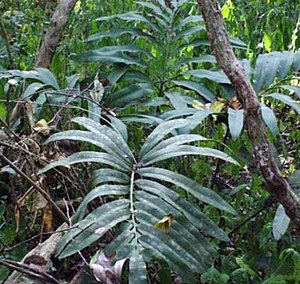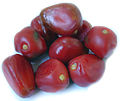Stangeriaceae
| Stangeriaceae | ||||||||||||
|---|---|---|---|---|---|---|---|---|---|---|---|---|

Stangeria eriopus |
||||||||||||
| Systematics | ||||||||||||
|
||||||||||||
| Scientific name | ||||||||||||
| Stangeriaceae | ||||||||||||
| LAS Johnson |
Stangeriaceae is the smallest of the three families in the order of the cycads (Cycadales).
There are fossils from the Jurassic known from sediments in the British Isles. Current studies suggest that the fossil taxon Mesodescolea , which comes from the Lower Cretaceous Argentina, also belongs to the family of the Stangeriaceae.
description
The species in this family are very long-lived, mostly evergreen plants. The leaves are usually simply pinnate leaf fronds that look very similar to fern fronds . But the Bowenia species have double-pinnate leaf fronds. Initially, the fronds are often rolled up like ferns. Unlike the similar palm fronds , the leaf veins of the cycads are forked ( dichotomous ). Most of the time, a wreath of new leaves forms at the same time, usually once a year. The older the plant, the more new leaves are formed each year.
The wood is rich in mucus ducts and has very broad radial medullary rays ("manoxyle wood"). Just like the conifers , the wood cells have pits . The root center (marrow) is partially rich in starch and serves as a place for storing reserve materials . On the outside, however, there is water-bearing fabric.
They are low plants with subterranean trunks and, thanks to their long fronds, reach heights of growth of a maximum of 2 meters. The trunks of cycads are mostly (apparently) unbranched. Only with the formation of fertile leaves ( sporophylls ) does it come to branching at the base of the fertile sections, because the cones are actually special shoot sections. After the seed has formed, the cones are pushed aside by a side bud.
Cycads are dioeciously separated, so there are both male and female individuals ( diocyte ). In the Stangeriaceae family, the plants of both sexes have cone-shaped inflorescences .
The carriers of the ovules are clearly visible in the cycads as the transformation of leaves. The cone is a side shoot axis ( homology ). After the seeds ripen, the cones are topped by a side bud and bent to one side. The pollination via beetle ( Cantharophilie ) or wind ( anemophily ).
The large pink to purple-red seeds have a three-layered seed coat, consisting of a colored sarcotesta, a woody sclerotesta and a membranous endotesta. The seedling has two cotyledons .
use
Plants in cultivated stands are used to obtain cut greenery and as a shade-tolerant garden ornamental plant. They are also suitable as indoor plants , but cannot be found in stores.
All species are strictly protected ( CITES ).
Systematics and distribution
The four species have their areas on land masses of the supercontinent Gondwana . All areas are close to the coast near sea level or on table mountains.
The Stangeriaceae family is divided into two subfamilies, each with one genus and a total of only three species:
- Subfamily Stangerioideae:
-
Stangeria
T.Moore : It is a monotypic genus with only one species in southeastern Africa ( Capensis ):
- Stangeria eriopus (Kunze) Baill. (Syn .: Lomaria eriopus Kunze , Stangeria paradoxa T. Moore )
-
Stangeria
T.Moore : It is a monotypic genus with only one species in southeastern Africa ( Capensis ):
- Subfamily Bowenioideae:
-
Bowenia Hook. : Endemic to Australian Queensland with two (or three) species. Only the cycads of this genus have double-pinnate leaf fronds. Leaves and seeds are poisonous. This belongs here:
- Bowenia spectabilis Hook. ex Hook. f.
- Bowenia serrulata (W. Bull) Chamb.
-
Bowenia Hook. : Endemic to Australian Queensland with two (or three) species. Only the cycads of this genus have double-pinnate leaf fronds. Leaves and seeds are poisonous. This belongs here:
With some authors, the two genera are also incorporated into the Zamiaceae family .
photos
Stangeria eriopus :
Habit at the location
Seedling on nutrient medium
swell
- Description of the family Zamiaceae therein the two genera. (engl.)
- Everything about cycads. (engl.)
- Information on the taxa within the Stangeriaceae. (engl.)
- Description of the University of Berkeley family. (engl.)







